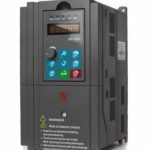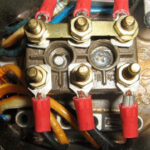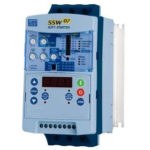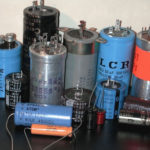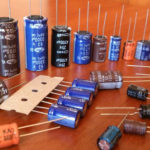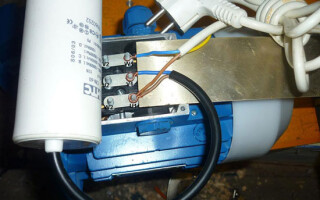Many hobbyists and professionals use electrical equipment for various purposes. And in many cases, electrical equipment is driven by three-phase motors. But three-phase network is often not available in garage boxes and individual homes. And then come to the aid of schemes for connecting a three-phase motor into a single-phase network.
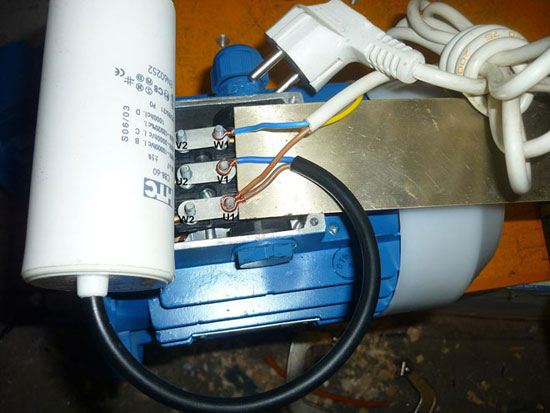
Contents
What a capacitor is for
Three-phase asynchronous AC motors with squirrel-cage rotor are the most common and are used in machine tools. We will consider their connection to a single-phase network. When a motor is plugged into a three-phase network, an alternating current flows through the three windings at different moments of time. This current creates a rotating magnetic field, which begins to rotate the motor rotor.
When you connect a motor to a single-phase network, current flows through the windings, but there is no rotating magnetic field, the rotor does not rotate. The way out of this situation was found. The simplest and most effective way turned out to be is to connect a capacitor in parallel to one of the motor windings. The capacitor, by pulsing energy, creates a phase shift, a rotating magnetic field is created in the motor windings and the motor runs. The capacitor is permanently energized and is called an operating capacitor.
IMPORTANT! Correctly calculate and select the capacity of the working capacitor and its type.
How to choose the right capacitors
Theoretically, it is supposed to calculate the necessary capacitance by dividing the current by the voltage and multiplying the obtained value by a factor. For different types of winding connections the coefficient is:
- star - 2800;
- delta - 4800.
The disadvantage of this method is that the data plate is not always saved on the electric motor. It is not possible to know the power factor and motor power and therefore the amperage accurately. In addition, factors such as mains voltage variations and the size of the load on the motor can affect the amperage.
| Motor power, kW | 0,4 | 0,6 | 0,8 | 1,1 | 1,5 | 2,2 |
| Capacitance of capacitor C2 in rated duty, μF | 40 | 60 | 80 | 100 | 150 | 230 |
| Capacitance of capacitor C2 in unloaded mode, uF | 25 | 40 | 60 | 80 | 130 | 200 |
| Capacitance of starting capacitor C1 in nominal mode, uF | 80 | 120 | 160 | 200 | 250 | 300 |
| Capacitor C1 in unloaded mode, uF | 20 | 35 | 45 | 60 | 80 | 100 |
Therefore, a simplified calculation of the capacitance of the working capacitors should be applied. Just consider that for every 100 watts of power you need 7 microfarads of capacitance. It is more convenient to use several small capacitors connected in parallel, preferably of the same capacity, than one large capacitor. By simply adding up the capacitance of the assembled capacitors, it is easy to determine and select the optimum value. First, it is better to underestimate the total capacity by ten percent.
If the motor starts easily and has enough power to run it, then you've got it right. If not, you need to connect more capacitors until the motor reaches optimum power.
TIP. When you connect a three-phase squirrel-cage induction motor to a single-phase network, at least one-third of its power is lost.
Keep in mind that a lot is not always a good thing, and if the optimum capacity of the operating capacitors is exceeded, the motor will overheat. Overheating can lead to the burnout of the windings and motor failure.
IMPORTANT! Capacitors must be connected in parallel.
It is desirable to choose capacitors with an operating voltage of not less than 450 volts. The most common are the so-called paper capacitors, with the letter B in their name. Currently there are also specialized so-called motor capacitors, e.g. K78-98.
WARNING! It is desirable to choose capacitors for alternating current. Using other capacitors is also possible, but is associated with a complication of the circuit and possible undesirable consequences.
If the motor is started under load and is heavy, a starting capacitor is also needed. It is connected in parallel with the operating capacitor for a short time of starting the motor. Its capacity should be equal or not more than twice the capacity of the working capacitor.
Schematic diagram for connecting a 380 to 220 volt electric motor with a capacitor
To connect a three-phase motor in a single-phase network is not difficult, and even an amateur electrician can cope with this. If difficulties arise, you should ask friends or acquaintances. There is always a competent electrician nearby.
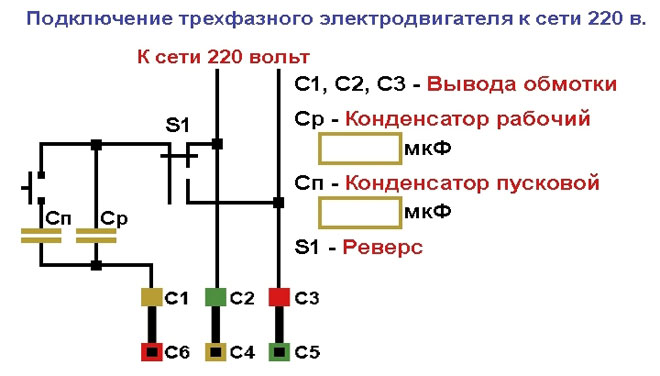
The windings of three-phase motors with an operating voltage of 380 to 220 for operation in a three hundred and eighty-volt network are connected in a star arrangement. This means that the winding ends are connected to each other, and the beginnings are connected to the mains. In order to be able to operate an electric motor in a single-phase 220 volt network, it is necessary to switch its windings to a delta circuit for the beginning. I.e. connect the end of the first with the beginning of the second, the end of the second with the beginning of the third and the end of the third with the beginning of the first.
These connections will be the motor leads to connect to the power supply. Two leads must be connected to zero and 220 volt phase via a two-pole switch. Connect the third lead through the working capacitors to either of the first two leads from the motor. You can try to start.
If the start-up is successful, the motor runs with acceptable power and does not get too hot, then you can leave nothing to change. You get a workable circuit only with working capacitors.

In case of starting under load or just heavy starting of the motor, it may spin up for a long time and not reach the acceptable power. Then it is necessary to include a starting capacitor in the circuit as well. The starting capacitors should be of the same type as the working capacitors. The same or twice the capacity of the working ones. They are connected in parallel with them. They are used only for starting the electric motor.
It is very convenient to use a peculiar switch of series AP for such starting. It is important that it be in the version with a block of contacts. In it, when the Start button is pressed, a pair of contacts remains closed until the Stop button is pressed. The motor terminals and the mains are connected to them. The third contact is closed only when the Start button is held, through it the starting capacitor is connected. Switches of this type, only without safety equipment, were often installed on old Soviet centrifugal washing machines.
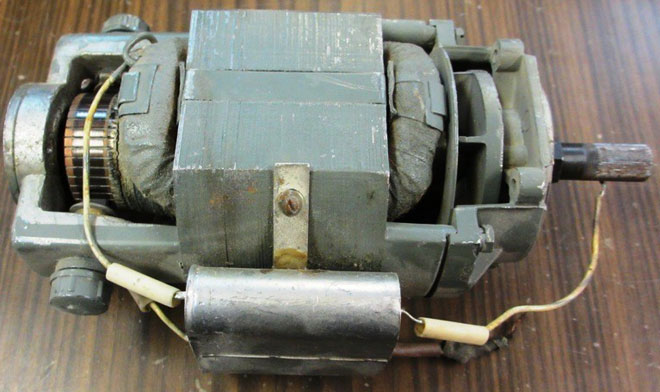
Wiring diagram for an electric motor without capacitors
There are no really working schemes for connecting a three-phase motor in a household network of 220 volts without capacitors. Some inventors suggest connecting motors via induction coils or resistors. Allegedly, this creates a phase shift by the required angle and the motor rotates. Others suggest thyristor wiring schemes. In practice, this does not work, and there is no need to reinvent the wheel. When there is a cheap and proven way to start by means of capacitors.
A really working option is to connect a three-phase induction motor via a frequency converter. The inverter is connected to the household network and produces three-phase current, with the possibility of soft start and speed regulation. But such a miracle costs from about 7000 rubles with a connected power of only 250 watts. Powerful devices are much more expensive. For such money you can buy electrical equipment with the ability to connect to a single-phase circuit. Be it a mini lathe, circular saw, pump or compressor.
How to connect in reverse
To ensure the rotation of the rotor in the reverse direction is not difficult. You need to add a two-position switch to the motor wiring diagram. The middle contact of the switch is connected to one of the capacitor contacts and the outer contacts to the motor leads.
WARNING! First you must select the direction of rotation with the switch and only then start the motor. When the motor is running, the direction of rotation switch must not be used.
The considered options for connecting industrial motors in the domestic network are not very difficult in their implementation. It is important only to pay attention to some nuances and the equipment, albeit with a small loss of power, will last long and be useful.
Related articles:
